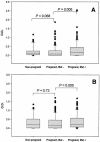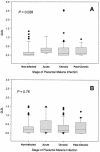Lack of an association between antibodies to Plasmodium falciparum glycosylphosphatidylinositols and malaria-associated placental changes in Cameroonian women with preterm and full-term deliveries
- PMID: 15322022
- PMCID: PMC517432
- DOI: 10.1128/IAI.72.9.5267-5273.2004
Lack of an association between antibodies to Plasmodium falciparum glycosylphosphatidylinositols and malaria-associated placental changes in Cameroonian women with preterm and full-term deliveries
Abstract
Sequestration of Plasmodium falciparum parasites within the placenta often leads to an accumulation of macrophages within the intervillous space and increased production of tumor necrosis factor alpha (TNF-alpha), a cytokine associated with placental pathology and poor pregnancy outcomes. P. falciparum glycosylphosphatidylinositol (GPI) anchors have been shown to be the major parasite component that induces TNF-alpha production by monocytes and macrophages. Antibodies against P. falciparum GPI (anti-PfGPI), however, can inhibit the induction of TNF-alpha and inflammation. Thus, the study was undertaken to determine whether anti-PfGPI antibodies down-regulate inflammatory-type changes in the placentas of women with malaria. Anti-PfGPI immunoglobulin M (IgM) and IgG levels were measured in 380 pregnant women with or without placental malaria, including those who delivered prematurely and at term. Results showed that anti-PfGPI antibody levels increased with gravidity and age and that malaria infection boosted anti-PfGPI antibodies in pregnant women. However, no association was found between anti-PfGPI antibodies and placental TNF-alpha levels or the presence of acute or chronic placental malaria. Furthermore, anti-PfGPI antibody levels were similar in women with preterm and full-term deliveries and were not associated with an increase in infant birth weight. Thus, these results fail to support a strong role for anti-PfGPI antibodies in the prevention of chronic placental malaria infections and malaria-associated poor birth outcomes.
Figures




Similar articles
-
IgG antibodies to synthetic GPI are biomarkers of immune-status to both Plasmodium falciparum and Plasmodium vivax malaria in young children.Malar J. 2017 Sep 25;16(1):386. doi: 10.1186/s12936-017-2042-2. Malar J. 2017. PMID: 28946883 Free PMC article.
-
IL-12 producing monocytes and IFN-gamma and TNF-alpha producing T-lymphocytes are increased in placentas infected by Plasmodium falciparum.J Reprod Immunol. 2007 Jun;74(1-2):152-62. doi: 10.1016/j.jri.2006.10.001. Epub 2006 Dec 27. J Reprod Immunol. 2007. PMID: 17194481
-
Association of naturally acquired IgG antibodies against Plasmodium falciparum serine repeat antigen-5 with reduced placental parasitemia and normal birth weight in pregnant Ugandan women: a pilot study.Parasitol Int. 2013 Jun;62(3):237-9. doi: 10.1016/j.parint.2013.01.006. Epub 2013 Feb 6. Parasitol Int. 2013. PMID: 23395684
-
Malaria in pregnancy: pathogenesis and immunity.Lancet Infect Dis. 2007 Feb;7(2):105-17. doi: 10.1016/S1473-3099(07)70022-1. Lancet Infect Dis. 2007. PMID: 17251081 Review.
-
Malaria blood-stage infection and its control by the immune system.Folia Biol (Praha). 2000;46(6):210-8. Folia Biol (Praha). 2000. PMID: 11140853 Review.
Cited by
-
The association of anti-phospholipid antibodies with parity in placental malaria.Clin Exp Immunol. 2005 Dec;142(3):512-8. doi: 10.1111/j.1365-2249.2005.02936.x. Clin Exp Immunol. 2005. PMID: 16297164 Free PMC article.
-
Malaria tolerance--for whom the cell tolls?Trends Parasitol. 2006 Aug;22(8):371-7. doi: 10.1016/j.pt.2006.06.002. Epub 2006 Jun 19. Trends Parasitol. 2006. PMID: 16784889 Free PMC article. Review.
References
-
- Andrews, K. T., and M. Lanzer. 2002. Maternal malaria: Plasmodium falciparum sequestration in the placenta. Parasitol. Res. 88:715-723. - PubMed
Publication types
MeSH terms
Substances
Grants and funding
LinkOut - more resources
Full Text Sources

